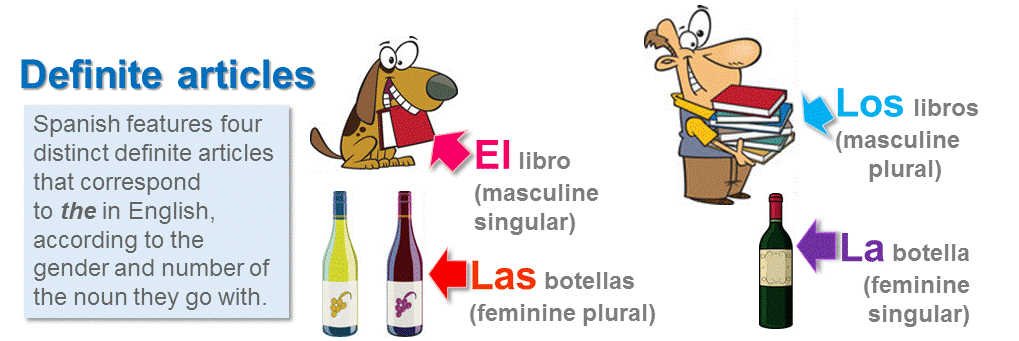Definite articles in Spanish are the topic we will learn today. First, you must know that there are two types of articles: definite and indefinite. In English, the definite article is «THE». Nevertheless, Spanish uses four different forms, as you can see below:

The Spanish definite articles, called «artículos determinados», agree in gender (masculine/feminine) and number (singular/plural) with the noun. Spanish and English differ substantially in how they use definite articles, as you will see from the notes and examples below. Learn more about the Spanish gender of nouns.
A tip: Learning new words along with their article will help you identify the gender of nouns quickly. For example, instead of learning just «flor» (flower), you must know «la flor», which will help you to remember that flower is feminine in Spanish.
Choosing the right Spanish definite article
Here are some examples of these definitive articles in action:
El árbol es grande. (The tree is big.)
Los libros son interesantes. (The books are interesting.)
La chica es alta. (The girl is tall.)
Las casas son blancas. (The houses are white.)
Using definite articles in Spanish
You come across many instances in Spanish where you use the definite article even though you may or may not use it in English. The rules in the following list show how you use definite articles in Spanish:
01. With nouns in a general or abstract sense:
El amor es maravilloso. (Love is terrific.)
02. With nouns in a specific sense:
La tía Ana trae regalos. (Aunt Ana brings gifts.)
03. With names of languages (except after the verb hablar and after the prepositions de and en):
Me gusta el español. (I like Spanish.)
¿Dónde está mi libro de español? (Where’s my Spanish book?)
Escríbame en español. (Write to me in Spanish.)
04. With parts of the body (when the possessor is precise) in place of the possessive adjective:
Me duelen los pies. (My feet hurt.)
05. With titles and ranks when you aren’t addressing the person:
La señora Rivera está aquí. (Mrs. Rivera is here.)
Siéntese, Señora Rivera. (Have a seat, Mrs. Rivera.)
06. With last names:
Los Gómez viven en Colombia. (The Gómezes live in Colombia.)
07. With days of the week (except after the verb ser):
El domingo voy a México. (On Sunday, I’m going to Mexico.)
Hoy es miércoles. (Today is Wednesday.)
08. With seasons (you may omit the article after en):
No trabajo en (el) verano. (I don’t work in the summer.)
09. With the hour of the day and other time expressions:
Son las once y media. (It’s 11:30.)
Salgo por la tarde. (I’m going out in the afternoon.)
10. With rivers, seas, and other geographical locations:
El Orinoco es un río. (The Orinoco is a river.)
11. As we said above, there are other articles called indefinite (in English, these are «a» and «an»). Let’s see how indefinite articles work in Spanish.
Definite articles exercises
Now is the time to practice what you have learned with this mini-test. You leave us a message in the comments with any questions or suggestions you have, our team will be happy to help you 🥰
Click on the link to watch a video with more information about articles in Spanish.
